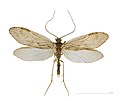| Hymenopterida | |
|---|---|
 | |
| Blue-eyed ensign wasp (Evania appendigaster) | |
| Scientific classification | |
| Kingdom: | Animalia |
| Phylum: | Arthropoda |
| Class: | Insecta |
| Clade: | Eumetabola |
| Clade: | Holometabola |
| Superorder: | Hymenopterida |
| Subgroups | |
Hymenopterida is a superorder of holometabolous (metamorphosing) insects. As originally circumscribed, it included Hymenoptera and the orders in Panorpida (Mecoptera, Siphonaptera, Diptera, Trichoptera and Lepidoptera). [1] However, more recent studies find Hymenoptera as sister to the other members of Holometabola and the superorder is restricted to Hymenoptera. [2]



